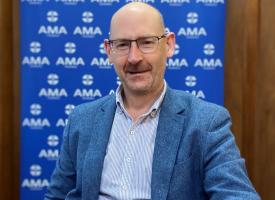AIHW Medical Workforce Report – Doctor numbers on the rise to face future medical challenges
AMA President, Dr Andrew Pesce, said today that the increase in doctor numbers reported by the Australian Institute of Health and Welfare (AIHW) is good news for the Australian community, but concerns remain about the ageing of the medical workforce, slower growth in GP numbers, and continuing doctor shortages in rural Australia.
The AIHW Medical labour force 2007 report shows there were an estimated 67,208 doctors practising medicine across Australia in 2007, which is an increase of 20.5 per cent from 2003. However, GP numbers grew by only 10 per cent over the same period and, unlike the overall medical workforce, the average age of GPs is rising.
Dr Pesce said that Australia is facing greater health challenges with an ageing population and more people with complex and chronic conditions, and a quality medical workforce in sufficient numbers is needed to face these challenges.
“It is a good sign that we have more doctors practising in the system now, but we must do more to ensure the growing numbers of students in medical schools have access to training opportunities in their intern years and beyond, once they have finished their university study,” Dr Pesce said.
“We need greater incentives to attract students to general practice.
“We need greater incentives to attract young GPs to practise in rural and remote Australia.
“And we need greater incentives to keep our current medical workforce in the system for longer.
“The demand for quality medical services in Australia will continue to grow, and people will want to see a doctor when they are sick or injured, chronically ill, or seeking preventive health advice.
“It is vital that governments commit to training and supporting more doctors, especially GPs, to meet the dramatically increasing primary care needs of the Australian population into the future.
“The Australian people expect and deserve quality GP-led primary care no matter where they live,” Dr Pesce said.
In regard to general practice, the report shows:
- GP numbers grew over the same period at a much lower rate - 10%. This highlights the need for the Government to continue to invest in efforts to support the GP workforce;
- The GP workforce, unlike the overall medical workforce, is continuing to age; and
- Rural areas are still not getting their fair share of doctors. There are 332 full time equivalent (FTE) doctors per 100,000 population in major cities and just 204 FTE doctors per 100,000 population, which supports the case for more incentives to get doctors working in rural and remote areas.
To address these medical workforce needs, the recently released AMA Priority Investment Plan for Australia’s Health calls for:
- The Government to support the Rural Rescue Package developed by the AMA with the Rural Doctors Association of Australia. Implementation of the Rural Rescue Package, costed at $375 million a year, would bolster the rural workforce and ensure that patients in rural communities have improved access to doctors. The Package encourages more doctors to work in rural and regional Australia and recognises essential obstetrics, surgical, anaesthetic and emergency skills. This funding would provide a two-tier incentive package, including further enhancements to rural isolation payments and rural procedural and emergency/on-call loading. The on-call loading in particular reflects the vital role that rural doctors have in providing emergency care for their patients when they need it, no matter what time of the day or week it is;
- By 2013, 3400 intern places guaranteed with processes under which States are accountable to the Commonwealth for delivering on this, and an annual process of monitoring by the Commonwealth to ensure that these places are provided;
- Commensurate increases in prevocational training places to meet the increasing number of junior doctors that complete their intern year;
- To restore the balance of service delivery and medical workforce training in our public hospital system and to support a sustainable and well-trained medical workforce, junior doctors must have better access to protected teaching time, while senior clinicians should be guaranteed at least 30 per cent of their ordinary working time to devote to clinical support activities such as teaching and training;
- Progressive increases in the number of first year vocational training places to 2,000 by 2015, over and above the GP training places outlined above, across both public and private settings;
- The new Health Workforce Agency (HWA) – in close collaboration with the medical profession through the AMA – to undertake comprehensive and robust medical workforce modelling of supply and demand requirements for the next 10 years to determine the detailed number of vocational training places required in each discipline. Following this process, there should be a Commonwealth-State Ministers summit to lock in the commitment required from governments to deliver on these additional vocational training places; and
- The Medical Training Review Panel to report annually on the availability of clinical training places for students at medical school, for doctors in training at prevocational and vocational levels, and to assess progress against the above targets established by the HWA. This should be accompanied by a Biennial Review of Clinical Training Places to identify training bottlenecks or shortages and to provide relevant policy advice to Government.
16 October 2009
CONTACT:
John Flannery 02 6270 5477 / 0419 494 761
Peter Jean 02 6270 5464 / 0427 209 753



